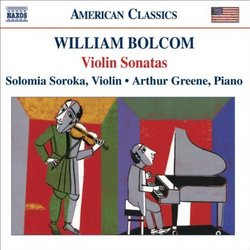| All Artists: William Bolcom, Arthur Greene Title: William Bolcom: Violin Sonatas Members Wishing: 1 Total Copies: 0 Label: Naxos American Original Release Date: 1/1/2006 Re-Release Date: 2/21/2006 Genre: Classical Styles: Chamber Music, Historical Periods, Classical (c.1770-1830), Instruments, Strings Number of Discs: 1 SwapaCD Credits: 1 UPCs: 636943915028, 636943915028 |
Search - William Bolcom, Arthur Greene :: William Bolcom: Violin Sonatas
 | William Bolcom, Arthur Greene William Bolcom: Violin Sonatas Genre: Classical
|
Larger Image |
CD Details |
CD ReviewsForty Years of Bolcom Violin Music J Scott Morrison | Middlebury VT, USA | 05/13/2006 (5 out of 5 stars) "Hard on the heels of three earlier Naxos releases of music by one of America's best composers, William Bolcom (b. 1938) -- including the transcendent 'Songs of Innocence and of Experience' -- we have here his four violin and piano sonatas performed by a married violin/piano duo, Solomia Soroka and Arhtur Greene, who are colleagues of Bolcom's at the University of Michigan in Ann Arbor. The first, written in 1956 when Bolcom was a freshman at the University of Washington, is astonishingly assured. (He did revise it many years later but says this was mostly just to excise some repetitive passages.) Its three movements culminate in a ten-minute set of variations subtitled 'Scenes from a Young Life,' based on a Beethovenian theme which still somehow manages to sound like an American folksong. Stylistic changes are wrung on the theme and it ends with a serene restatement, almost hymnlike, interrupted by a manic bitonal scalar expostulation by the two instrumentalists.
Sonata No. 2 (1978) was dedicated to the memory of the great jazz violinist, Joe Venuti, who had died while he was composing it. It was written for Sergiu Luca, who had been closely associated with Venuti. The first movement, called 'Summer Dreams,' is a swinging blues with a wild middle section. This is followed by 'Brutal, fast' which is tempestuously virtuosic for both players; it is almost Bartokian in its ferocity. III is an inward Adagio that ends in an ecstatic hymn. (Bolcom has the ability to write the simplest music that yet expresses deep feelings.) IV is directly influenced by the music of Venuti and is a sometimes dreamy, sometimes volatile 'Venutian salsa.' The Third Sonata (1993) was commissioned to honor the 75th birthday of fabled violin teacher, Dorothy DeLay, by the Aspen Music Festival, where she had been a guiding presence for many years, and was premiered by one of her eminent pupils, Nadia Salerno-Sonnenberg. Subtitled 'Sonata Stramba' -- 'stramba' is Italian for 'weird' -- it is a four-movement, twenty-minute piece that is expressionist in impact until the fourth movement which sounds for all the world like a Piazzolla tango refracted through Bolcom's musical lens. Sonata No. 4 (1996) has a spiky allegro first movement followed by II, 'White Night,' meant to convey insomnia -- not quite spooky, not quite frantic, sometimes musing, sometimes humming to itself. III and IV are an Arabesque and Jota, with Moorish/Spanish melisma. Are those snap pizzicati in III, or is the violinist knocking on the body of her violin? Whatever the source, this addition of percussion to the mix helps to convey an exotic flavor that is hypnotic. These are attractive, powerfully crafted works that represent a significant addition to the canon of American violin sonatas. They are not quite as evocative as those by Ives, but they can be mentioned in the same breath as those masterworks. The performances by Soroka and Greene, praised in the very helpful booklet notes by the composer, can be assumed to be authoritative. Scott Morrison" |

 Track Listings (15) - Disc #1
Track Listings (15) - Disc #1